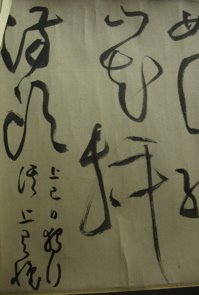 The Metropolitan Museum of Art's current special exhibition "Brush and Ink: The Chinese Art of Writing" (September 2, 2006–January 21, 2007).
The Metropolitan Museum of Art's current special exhibition "Brush and Ink: The Chinese Art of Writing" (September 2, 2006–January 21, 2007).It's interesting to take time out to appreciate the art of writing. Is this something that is lost in today's typeset computer-driven culture? True, there are interesting typographical fonts and some designers use them artistically, but what about the art of handwriting? Is it lost today?
I spent a lot of time as a child thinking about the way my handwriting looks--I wanted to make it unique and beautiful. Though it's a bit messy (due to disuse and being left-handed), I believe there are still little artistic flourishes in it (or is it just entirely sloppy?). Do children still think about this, or is it a dying art?
Is the same issue true in Asia? Undoubtedly. But it seems that it would be different, somehow, because of the pictographic elements of the characters, which lend themselves to artistic enterpretations far more intricate than the Western alphabet.
 Though the exhibit at the Met spans centuries (and as the same type of show about Western writing would be inherently similar), it's still important to take time and think about language and how it is represented. It can be extremely basic, or so beautiful that it conveys much more than the words themselves.
Though the exhibit at the Met spans centuries (and as the same type of show about Western writing would be inherently similar), it's still important to take time and think about language and how it is represented. It can be extremely basic, or so beautiful that it conveys much more than the words themselves.Towards the end of the show, there are pieces by the contemporary artist Xu Bing, whose work is extraordinarily interesting in the context of the Met's show. He has developed a way to arrange western letters so the words look like pitctograms, and at first glance, to someone who can't read Chinese, it looks like yet another scroll in a slightly different style. But upon closer examination (and reading the key), an wonderful world opens up--a magical, beautiful new way to read and represent the English language.

No comments:
Post a Comment